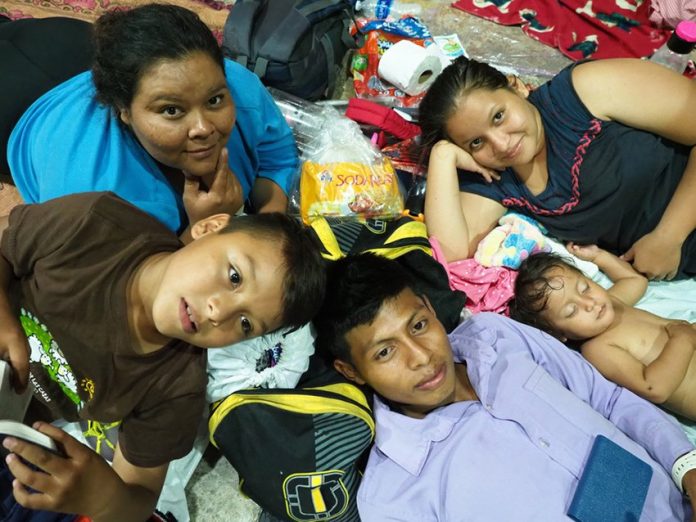As a single, female photographer the thought of joining thousands of migrants from the most dangerous countries in Latin America was intimidating. I knew of Honduras’ reputation and seen its murder statistics.
But news about the caravan was patchy at best. It covered issues such as the storming of the border between Mexico and Guatemala. What was not being covered was the day to day reality of the journey.
So I decided to fly down to Tapachula, Chiapas, to see for myself. My intention was to spend a couple of days with it, but in the end I stayed for a week as it traveled from Tapachula to Arriaga, also in Chiapas.
I caught up with the migrants in Huixtla at 5:00am on October 23, arriving at a street cordoned off by yellow police tape. It was one of the side streets that led to the main square, approximately 150 meters from the center of town, and I saw dozens of migrants sleeping or beginning to wake up.
What I didn’t know at that point was that I wasn’t in the center of the group, but only on the outskirts. People had grouped together to find safety in numbers.
I spoke to a woman and her husband who were traveling with her four children, her brother, her niece and nephew. Her niece was four months’ pregnant and hungry. I had recently worked with clinicians in the mountains of Guatemala who told me that children are living in such extreme poverty that it is affecting the development of their brains.
While most people in the caravan later told me that they were well fed thanks to the donations of Mexican municipalities, I worried about the girl based on what the clinicians had told me.
I walked down the street towards the main square of Huixtla as the morning sun was beginning to rise above the buildings. Down one of the streets appeared to be groups of mostly men, and I began to feel intimidated. And then people began calling me to have their photographs taken, ask me where I was from, or why I was there.
The more I talked to them, the less intimidated I felt. The reality was that I was talking to young, driven people who were desperate for a better way of life.
Hearing their stories was shocking but it was nothing compared to watching them trudge as a unified group to the next town — Mapastapec. They walked four or five abreast and in a line of people that was many kilometers long. The photographs in the media had attempted to show the size of the group, but the reality was overwhelming.
I asked my driver to stop to let some people on to the back of our truck and within seconds it had filled with travelers, including children as young as three. With men hanging off the sides, and the truck looking dangerously overloaded, we set off.
[soliloquy id=”64350″]photos by Alex Harrison-Cripps
I saw vehicles of all shapes and sizes stopping to help carry people between the towns, with dozens of people piled precariously on top. The younger men would take the more dangerous positions at the back of vehicle, standing on nothing but a small wooden slat or a rear bumper between them and the highway.
Police occasionally stopped dangerously overloaded vehicles, but an officer confirmed that their role was not to impede the caravan but to assist in ensuring its safe passage. A Red Cross volunteer told me that the police at the back of the caravan were flagging down vehicles to assist migrants struggling with the day’s journey.
Meanwhile, at the side of the road Mexicans cheered and held signs welcoming the migrants, and set up stands offering water, clothes, food, diapers, sanitary towels and disposable underwear.
On the night of Thursday, October 25 we arrived in the town of Pijijiapan where a DJ played music from the balcony of a local municipal building, providing a festival vibe. Two couples began to dance and hundreds of others surrounded them in two circular audiences.
At around 10:00pm I found myself being pushed into the middle of one of the circles, which consisted almost entirely of young men. The cheering started and I began to feel vulnerable and very aware of being a lone female. The fear was unwarranted. The group wanted me to photograph the dancers and ultimately to join in.
Before long I was the one dancing with a young man who seemed more embarrassed than I was, while the people surrounding me cheered and laughed.
Despite the incredible hardship that these people have left and are continuing to endure in the caravan, without exception everyone I met was polite, funny and interesting. It’s not possible to predict how all this will end, but any state should be lucky to consider such hardworking, driven and resourceful people as its citizens.
The writer is a British photographer currently living and traveling in Mexico.
